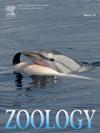Reproductive investment in the knifefish Brachyhypopomus occidentalis
IF 1.6
3区 生物学
Q2 ZOOLOGY
引用次数: 0
Abstract
An organism's ability to produce viable offspring, or reproductive fitness, often depends on several environmental and ecological factors such as temperature, food availability and predation. Changes in these factors can act as stressors, forcing organisms to optimize energy allocation, resulting in trade-offs. In this study, we investigate the reproductive biology of the South American electric fish Brachyhypopomus occidentalis, examining whether perceived predation risk can influence reproductive output. We sampled four populations during the reproductive season at two pairs of sites with differing levels of predation risk across independent river drainages. We assessed several traits including sexual dimorphism and reproductive traits such as gonad mass, fecundity, and gamete morphology parameters. Our findings reveal physical sexual dimorphism, with males being larger and heavier than females. Individuals from low predation risk sites were significantly larger, had heavier gonads, and exhibited higher gonadosomatic indices. Females from low predation risk sites invested more in gonad development, showing increased relative and absolute fecundities and higher oocyte counts at each maturity stage. Collectively, our results strongly suggest that predation risk plays a significant role in shaping reproductive strategies in electric fishes and also underscore how ecological pressures can drive variation in reproductive investment across fish populations.
西方短刀鱼的生殖投资
生物体产生可存活后代的能力,或繁殖适应性,通常取决于几个环境和生态因素,如温度、食物供应和捕食。这些因素的变化可以作为压力源,迫使生物体优化能量分配,导致权衡。在这项研究中,我们研究了南美电鱼Brachyhypopomus occidentalis的生殖生物学,研究了感知捕食风险是否会影响生殖输出。在繁殖季节,我们在独立河流流域的两对不同捕食风险水平的地点取样了四个种群。我们评估了一些性状,包括两性二态性和生殖性状,如性腺质量、繁殖力和配子形态参数。我们的发现揭示了生理上的两性二态性,男性比女性更大更重。来自低捕食风险地区的个体明显更大,性腺更重,性腺指数更高。来自低捕食风险地区的雌性在性腺发育上投入更多,在每个成熟阶段显示出更高的相对和绝对繁殖力和更高的卵母细胞计数。总的来说,我们的研究结果强烈表明,捕食风险在塑造电鱼的生殖策略中起着重要作用,也强调了生态压力如何驱动鱼类种群的生殖投资变化。
本文章由计算机程序翻译,如有差异,请以英文原文为准。
求助全文
约1分钟内获得全文
求助全文
来源期刊

Zoology
生物-动物学
CiteScore
3.90
自引率
0.00%
发文量
37
审稿时长
70 days
期刊介绍:
Zoology is a journal devoted to experimental and comparative animal science. It presents a common forum for all scientists who take an explicitly organism oriented and integrative approach to the study of animal form, function, development and evolution.
The journal invites papers that take a comparative or experimental approach to behavior and neurobiology, functional morphology, evolution and development, ecological physiology, and cell biology. Due to the increasing realization that animals exist only within a partnership with symbionts, Zoology encourages submissions of papers focused on the analysis of holobionts or metaorganisms as associations of the macroscopic host in synergistic interdependence with numerous microbial and eukaryotic species.
The editors and the editorial board are committed to presenting science at its best. The editorial team is regularly adjusting editorial practice to the ever changing field of animal biology.
 求助内容:
求助内容: 应助结果提醒方式:
应助结果提醒方式:


